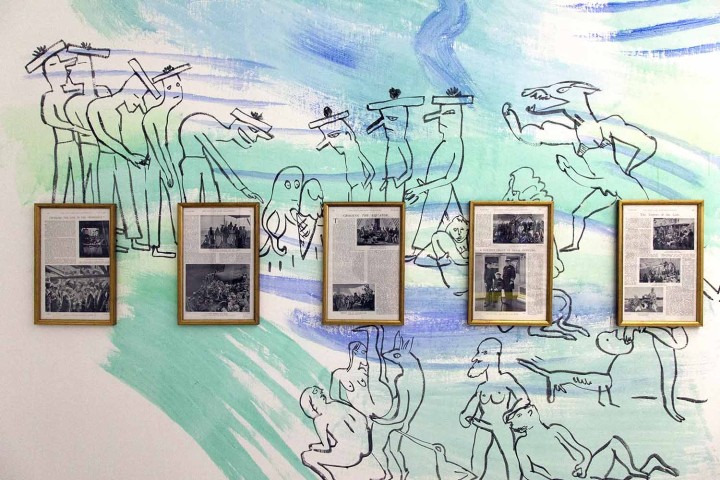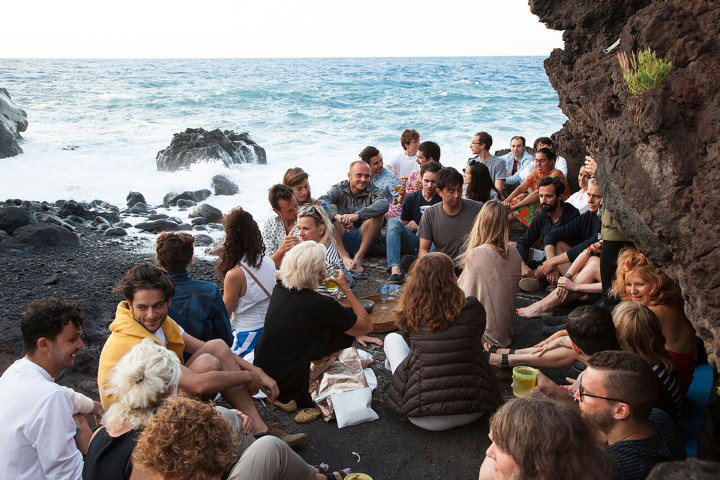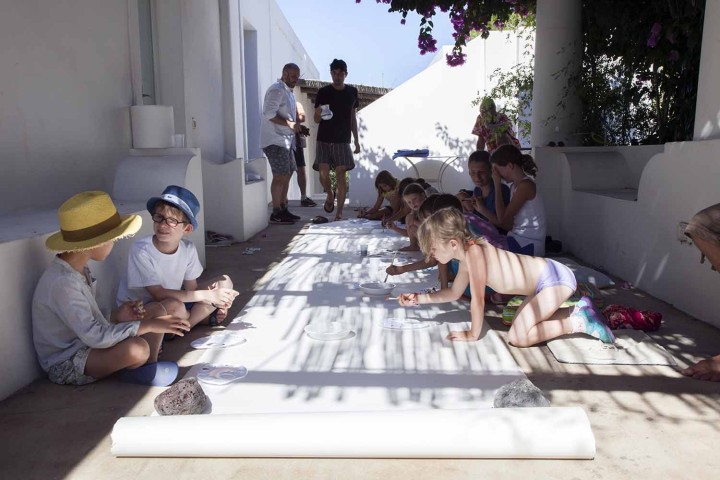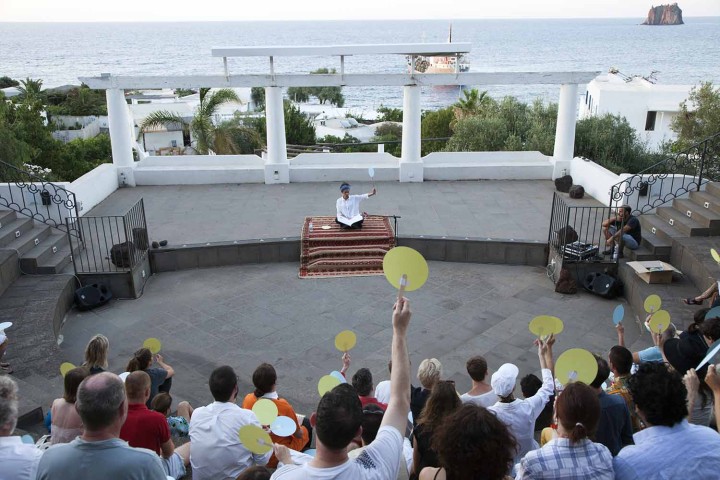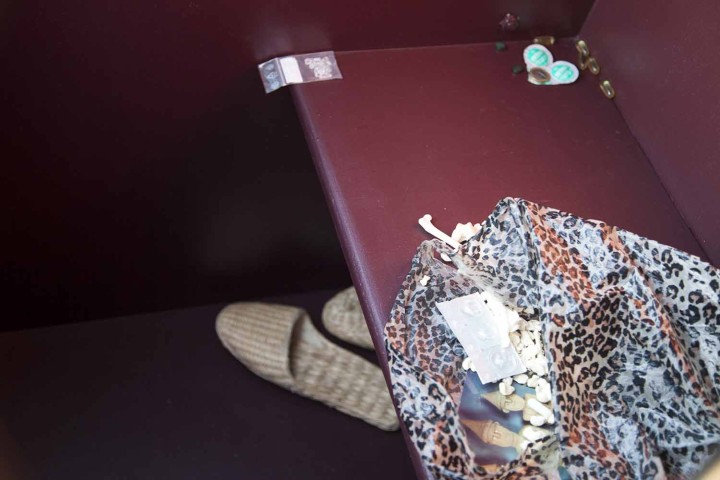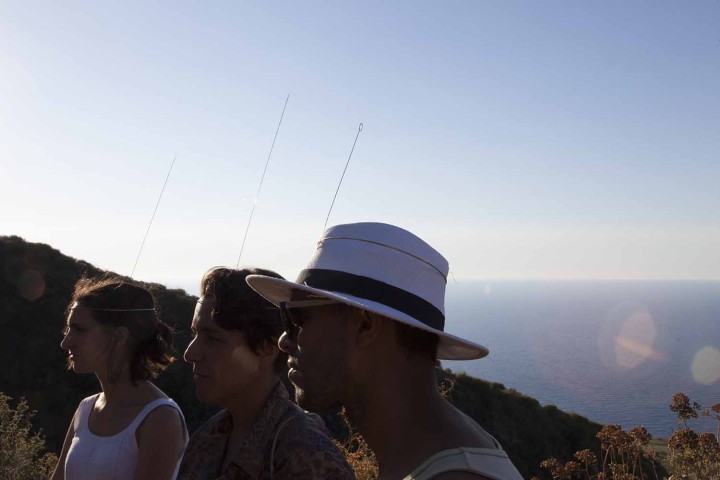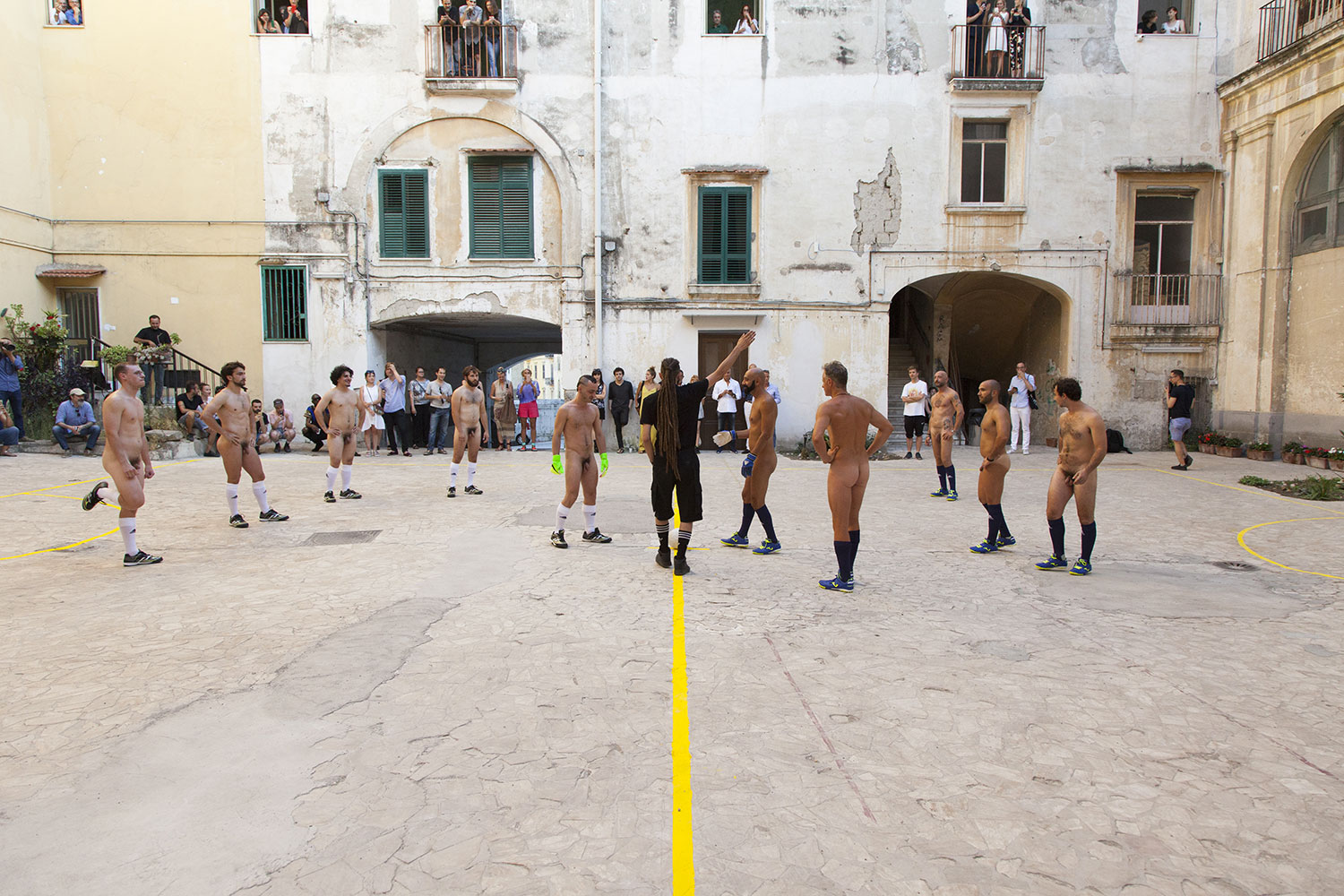From Homer to James Joyce, the peripatetic journey of Ulysses underlied “I Will Go Where I Don’t Belong,” the sixth edition of Volcano Extravaganza, led by French artist Camille Henrot with curator Milovan Farronato. Amid ominous waves and strong Aeolian winds, news of canceled ferry boats and people being stranded on their way to the Sicilian island of Stromboli, the week-long festival opened under the appropriate theme of naufrage.
In the domestic setting of the Fiorucci Art Trust House, a group exhibition curated by Camille Henrot explored the allure, perils and exoticism of navigation and shipwreck with depth and a touch of humor. Entering the gallery, one was met with a mural drawn by Henrot with swift and incisive strokes, of fantastical creatures and men copulating in extravagant positions among blue waves. Artists’ contributions found their place alongside vintage prints of ships at the mercy of the elements and curious black-and-white photographs of life at sea from Henrot’s family collection. In this context, Mike Nelson’s sculpture Diyagram (Amnesiac beach fire), Maria Loboda’s Witch’s Ladder, composed of a marine rope intertwined with pheasant feathers, and Isola e Norzi’s Elsewhere, a telescope through which a point in the landscape refers back to itself, conjured the life of a castaway in an otherworldly, spellbound dimension. A YouTube video of sailors in drag parading for a beauty pageant found its counterpoint in a series of prints illustrating the propitiatory ceremony of Crossing the Line. The rite marks the passage of the equatorial line into what was believed to be an inverted world, where people walked upside down, men became women and social ranking was turned on its head. The trepidation and erotic desire connected to a subversion of roles and the possibilities of becoming other set the tone for the week ahead.
For the first time, Volcano Extravaganza shifted its focus from the erupting energy of Mount Stromboli to an introspective dimension, by reflecting on the mutable and unsettling condition of ‘belonging’, with evenings dedicated to the exploration of themes such as ‘isolation’, ‘inadequacy’ and ‘danger and eroticism of distances’ among others. The volcano seemed to respond by taking a background role, rumbles and puffs of smoke discretely punctuating the hours. Artist David Horwitz shared aphrodisiac and prophetic herbal infusions, inviting people to record their dreams while on the island — the volcano is known to procure vivid and prescient dreams. Maria Loboda’s enigmatic piece Nobody could explain this, that’s the way it was, a sedan chair whose interior displayed objects left behind — a fur stole, a tub of Advil, slippers, bleached animal bones — appeared each night at a different location like a vision, alluding to a mysterious and elusive presence that seemed to precede one on the journey.
Invited artists spent three weeks at the Fiorucci residence “La Lunatica” producing site-specific works. Presentations included screenings, exhibitions, music events in collaboration with Vinyl Factory and other gatherings, all providing a blend of entertainment and opportunities for exchange and reflection. Although the festival is free and open to the public, it is attended mostly by an inner circle of artists, curators, collectors and journalists, none of whom “belong” on the island but many of whom feel compelled to return. It was soon apparent that, whether an artist or participant, one had to surrender to the natural elements and embrace a spirit of jovial improvisation.
After days spent in failed attempts to cross the turbulent seas, artist Ragnar Kjartansson found land, much like a Robinson Crusoe washed ashore with a guitar as his only resource. His performance, rearranged from a beach at sunset to the open-air arena of the local nightclub Megà, took on an enthralling and tragicomic air. The occasion deserved bursts of fireworks and a champagne toast as his blasé delivery was accompanied by two enchanting assistants — who acted as living microphone stands — and aided by the bewitching voice of singer Kristín Anna Valtýsdóttir. After all, he pointed out, the best way to reach Stromboli from Iceland should have been through the connected craters of volcanoes as described in Jules Verne’s Journey to the Center of the Earth.
The negotiation of interior and exterior worlds, their fluidity and interchange, was a recurrent thread. Having spent long periods of time on Stromboli over the last couple of years, artist Joana Escoval invited participants to follow her for a walk into unknown territory. With the help of volcanological guide Stefano Oliva, the artist created a new trail through the thick vegetation of the mountain, opening up a pathway that would be walked for the first time and then soon disappear, engulfed by wild shrubbery. Away from the tourist-beaten track, the participants set out late and proceeded slowly, a haphazard group ill equipped for trekking but keen on discovering what lay ahead. The path was punctuated by stops in which metal objects created by the artist — who experiments with the effects of metal bonds on her skin, breath and moods — were selected in the landscape. Like antennas receiving signals from the ether, the metal objects were worn or carried along the way, acting as conductors between the energy of the body, the mind and that of the environment.
A different kind of negotiation was required at Amira Ghazalla’s powerful delivery of the meandering story Buffalo Head — collectively written by Camille Henrot with Jacob Bromberg, David Horvitz, Maria Loboda and Milovan Farronato — in which participants were elicited to democratically vote at each narrative bifurcation, sending the protagonist into a tale of sexual transformation, disguise, endless wailing and desperation, or a princely marriage.
The figure of Karin in the iconic Rossellini movie set on Stromboli — a displaced POW who fails to integrate with the conservative and closed-minded island community — was another point of reference when exploring states of displacement and alienation. Touched by the personal histories of people who found Stromboli a more hospitable place and chose the island — a site of postwar exodus and now a holiday destination — as their home, an important part of the festival involved local inhabitants in a hosting role. For five nights, Strombolians opened their homes for pleasant evenings around mouthwatering home-cooked food and the screening of movies selected by Henrot. In the era of Netflix, gathering together in front of a television transported one back to the times when this was a social and community-reaffirming experience.
Under the auspices of a hypnotic red moon, the festival concluded with Exile, a shared nighttime journey back to Naples for a final stop at Camille Henrot’s exhibition Luna di Latte at Madre. The striking 1980s-inspired interior of the neon-lit Siremar restaurant provided an anachronistic and suggestive setting for a “glam” gala. While some passengers were already asleep on deck, David Horvitz distributed the last of his magical infusions, and participants took turns throwing hand-blown glass spheres containing the artist’s breath overboard into the moonlit waves, speculating aloud about the exotic shores to which they might be carried.
Whether escaping, arriving, leaving, being stranded or choosing to make a foreign place one’s home, the idea of life’s transience permeated the experience of Volcano Extravaganza, which this year turned away from the spectacular in favor of what felt like a contemplative experience. Thus, although engaged with pressing themes of exile and displacement, the curators chose to steer away from the current crisis in the Mediterranean, opting for a mythical and existential reflection. The evening concluded with Anna Boughigian’s poignant speech, reflecting on the painful and isolating nature of exile as well as the endless possibilities that dislocation affords: “At the end does anybody belong to the planet? I don’t know if anybody really belongs to this planet. So everybody who lives on this planet somehow is in exile.” As the temporary community that was drawn together during the week dispersed to other ports and onward journeys, one could not help feeling the fragile equilibrium of our sheltered, privileged existence.

